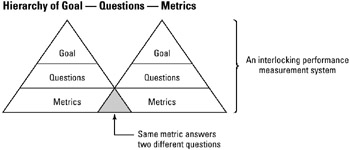Tool 16: Basili Data Collection Method
| AKA | N/A |
| Classification | Planning/presenting (PP) |
Tool description
The Basili data collection method is a process of establishing a performance measurement system that can be applied throughout the organization. First introduced by V. R. Basili (1984), this eight-step model interlocks goals with performance questions and with metrics that respond to the questions stated.
Typical application
-
To create specialized metrics that will measure goal attainment.
-
To design a data collection methodology that is supportive of performance measurement requirements.
Problem-solving
| Select and define problem or opportunity | |
| Identify and analyze causes or potential change | |
| Develop and plan possible solutions or change | |
| → | Implement and evaluate solution or change |
| → | Measure and report solution or change results |
| Recognize and reward team efforts |
Typically used by
| Research/statistics | |
| Creativity/innovation | |
| 4 | Engineering |
| 3 | Project management |
| Manufacturing | |
| Marketing/sales | |
| Administration/documentation | |
| Servicing/support | |
| 1 | Customer/quality metrics |
| 2 | Change management |
before
-
Process analysis
-
Information Needs Analysis
-
Major program status
-
Delphi Method
-
Qestionnaires
after
-
Objectives matrix (OMAX)
-
Run-it-by
-
Data collection strategy
-
Action plan
-
Surveying
Notes and key points

Step-by-step procedure
-
STEP 1 A team is assembled for the purpose of determining data collection goals. See example Data Collection for Integrated Product Development (IPD).
-
STEP 2 Answers to a list of questions are brainstormed. These questions point to specific data requirements necessary to measure goal attainment aspects.
-
STEP 3 To provide specific performance data, metrics are developed and documented.
-
STEP 4 An easy-to-use data collection form is designed.
-
STEP 5 The data collection and validation process is started.
-
STEP 6 Collected data are analyzed for anomalies.
-
STEP 7 Results are communicated to process owners and other involved groups.
-
STEP 8 The team determines how the results of perfomance measurement can be utilized to improve processes.
Example of tool application
| Data Collection for Integrated Product Development (IPD) |
|---|
|
| Notes: Partial data collection plan. Same metric answers two different questions. |
EAN: 2147483647
Pages: 326